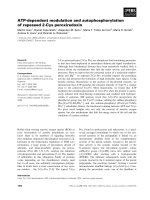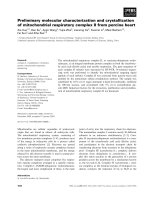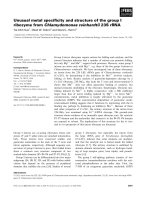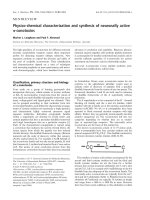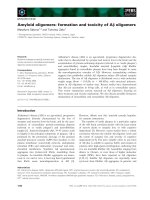Báo cáo khoa học: "Spontaneous intratumoral bleeding and rupture of giant gastric stromal tumor ( 30 cm) in a young patient" pot
Bạn đang xem bản rút gọn của tài liệu. Xem và tải ngay bản đầy đủ của tài liệu tại đây (443.12 KB, 5 trang )
BioMed Central
Page 1 of 5
(page number not for citation purposes)
World Journal of Surgical Oncology
Open Access
Case report
Spontaneous intratumoral bleeding and rupture of giant gastric
stromal tumor (> 30 cm) in a young patient
Ruy J Cruz Jr*
1
, Rodrigo Vincenzi
1
, Bernardo M Ketzer
1
, Andre L Cecilio
1
and
Lourdes A Cepeda
2
Address:
1
Department of Surgery, University of Santo Amaro Medical School, Sao Paulo, Brazil and
2
Department of Pathology, University of Santo
Amaro Medical School, Sao Paulo, Brazil
Email: Ruy J Cruz* - ; Rodrigo Vincenzi - ; Bernardo M Ketzer - ;
Andre L Cecilio - ; Lourdes A Cepeda -
* Corresponding author
Abstract
Background: Few cases of GIST bigger than 15 cm have been reported in medical literature, all
primarily in elderly patients. We report an unusual case, in which a giant gastric GIST – in a young
patient – presented as spontaneous intratumoral bleeding followed by intraluminal rupture.
Case presentation: A 37-year-old man was admitted with an acute onset of abdominal pain. CT
showed a 32 × 25 cm mass with some cystic lesions and areas of calcification. Twelve hours after
admission the patient presented with an episode of upper GI bleeding, and a significant decrease of
tumor size and hemoglobin level. An upper endoscopy showed a large bulge in the posterior aspect
of the gastric wall, and a small ulcer with continuous bleeding coming from a central orifice. A
subtotal gastrectomy was carried out. Pathological examination showed a giant gastric GIST
measuring 32 × 25 × 21 cm and weighing 3.750 g. Immunohistochemical staining demonstrated
positive reactivity to C-kit protein, CD34, and α-smooth muscle actin; but negative reactivity to S-
100 protein.
Conclusion: Intratumoral bleeding is a very rare presentation of GIST; preoperative diagnosis is
always made difficult by the absence of pathognomonic signs or symptoms. Emergency local
excision with negative margins associated with adjuvant therapy with imatinib mesylate remains the
main modality of treatment for high risk GISTs.
Background
Gastrointestinal stromal tumor (GIST) is a generic name
for a mesenchymal tumor originating in the muscular
wall of hollow viscera that expresses the c-kit proto-onco-
gen protein [1-3]. Most GISTs are larger than 5 cm in
diameter at time of diagnosis, with a diameter of 10 cm
being associated with a higher risk of local or distant
metastasis. Few cases of GIST bigger than 15 cm have been
reported in medical literature, all of them in elderly
patients. Gastrointestinal bleeding is the most common
presentation (50%) of GISTs and is usually associated
with a ulceration of the tumor into the lumen [4,5].
We report an unusual case, in which a giant gastric stro-
mal tumor (diameter >30 cm) is presented in a young
Published: 15 July 2008
World Journal of Surgical Oncology 2008, 6:76 doi:10.1186/1477-7819-6-76
Received: 10 March 2008
Accepted: 15 July 2008
This article is available from: />© 2008 Cruz et al; licensee BioMed Central Ltd.
This is an Open Access article distributed under the terms of the Creative Commons Attribution License ( />),
which permits unrestricted use, distribution, and reproduction in any medium, provided the original work is properly cited.
World Journal of Surgical Oncology 2008, 6:76 />Page 2 of 5
(page number not for citation purposes)
patient as spontaneous intratumoral bleeding followed by
intraluminal rupture.
Case presentation
A 37-year-old man was admitted to the emergency depart-
ment of the University of Santo Amaro Medical Center
with symptoms of abdominal pain. The patient reported
a progressive fatigue and increase of abdominal girth for
the last 5 months. The day before his admission the
patient reported nausea, vomiting, and vague but persist-
ent abdominal pain. Upon physical examination the
patient was fully conscious and alert with a heart rate of
100 beats/min, a blood pressure of 115/65 mmHg, afe-
brile, and slightly malnourished. Abdominal examination
revealed abdominal distension with a firm 30 × 30 cm
palpable mass in the upper abdomen with minimal
intrinsic mobility. Bowel sounds were hypoactive and rec-
tal examination revealed an empty ampulla. Blood tests
included a hemoglobin level of 8.4 g/dL, a white blood
cell count of 12.800/mm
3
(4 band and 70 segmented neu-
trophils), platelets of 495.000/μL. Coagulogram, liver
function tests, creatinine, and BUN were normal.
An abdominal X-ray showed a diffuse opaque area in the
upper abdomen without a gastrointestinal gas shadow;
hepatic colon flexure was dislocated downward, and the
stomach to the corner of the abdomen (Figure 1A). A CT-
scan was performed on the patient which showed a 32 ×
25 cm mass with a central thickened septa like enhancing
solid component, some cystic lesions, and areas of calcifi-
cation in the tumor (Figure 1B and 1C).
Twelve hours after admission the patient presented with
an episode of upper gastrointestinal (GI) bleeding, a sig-
RadiologyFigure 1
Radiology: A) Abdominal X-ray showing a diffuse opaque area in upper abdomen without a gastrointestinal gas shadow,
hepatic colon flexure was dislocated downward (HCF), and the stomach (S) to the left side.B and C). Abdominal computed
tomography scan showing heterogenous mass occupying most part of the abdominal cavity.
World Journal of Surgical Oncology 2008, 6:76 />Page 3 of 5
(page number not for citation purposes)
nificant reduction of the palpable mass to 25 × 25 cm, and
a decrease of the patient's hemoglobin level to 6.4 mg/dl.
Fluid resuscitation was started immediately and the
patient was transfused with two units of red blood cells.
After hemodynamic stabilization an upper endoscopy was
performed, showing a large bulge in the posterior aspect
of the gastric wall with a small ulcer (1 cm in diameter)
with edematous margins in the posterior part of the
antrum, and significant bleeding coming from a central
orifice.
Under the diagnosis of persistent GI bleeding an emer-
gency laparotomy was performed. A large cerebroid and
hypervascularized mass occupying the entire abdominal
cavity was observed, arising from the distal part of the
stomach. No other significant findings such as ascites or
locoregional metastasis were found at this time. A subto-
tal gastrectomy and omentectomy was carried out, and the
tumor was completely ressected (Figure 2A). The surgical
margins were then found to be tumor free.
The ressected mass was a well-circumscribed tumor
weighting 3.750 g and measuring 32 × 25 × 21 cm. Cut
Clinical photographs and photomicrographsFigure 2
Clinical photographs and photomicrographs. A) A large, cerebroid and hypervascularized mass occupied the upper
abdomen. The tumor arises from the distal part of stomach. B). The ressected mass: a well-circumscribed tumor measuring 30
× 25 × 21 cm and weighting 3.750 g. Cut sections demonstrated a pink, gray and fish-flesh appearance solid parenchyma with
focal areas of necrosis, and several blood-filled cysts. C). Microscopically, the tumor was characterized by spindle-shaped
tumor cells with acidophilic cytoplasm surrounded by a well-defined cell membrane (Hematoxylin & Eosin ×200). D). Immuno-
histochemical staining of the tumor tissue demonstrates positive reactivity to c-kit.
World Journal of Surgical Oncology 2008, 6:76 />Page 4 of 5
(page number not for citation purposes)
sections demonstrated a pink, gray, and fish-flesh appear-
ance. The solid parenchyma had focal areas of necrosis,
and several blood-filled cysts (Figure 2B). The small ulcer
located in the posterior aspect of the gastric wall presented
a communication with the larger cystic cavity.
Microscopically, spindle-shaped tumor cells with acido-
philic cytoplasm surrounded by a well-defined cell mem-
brane were growing externally from the gastric muscular
propria. Nuclear atypia was prominent with mitotic activ-
ity of 10 mitoses/50 high-power field. Immunohisto-
chemical staining demonstrated positive reactivity to C-
kit protein, CD34, and α-smooth muscle actin, but nega-
tive reactivity to S-100 protein.
The patient had an uneventful postoperative course and
was discharged on the eighth postoperative day. The
patient was put on imatinib mesylate 400 mg daily, and
followed up in the outpatient clinic without any signs of
recurrence 12 months after surgery.
Discussion
Gastrointestinal stromal tumor (GIST) is a generic name
for a mesenchymal tumor originating in the muscular
wall of a hollow viscera that expresses the c-kit proto-
oncogen protein. The expression of this protein distin-
guishes GIST from the true leiomyomas, leiomyoblasto-
mas, and other mesenchymal tumors of the GI tract [1-
3,6,7]. Most gastrointestinal mesenchymal tumors belong
to the category of GIST; except in the esophagus where
typical leiomyomas are more common than GISTs [5,6].
In general, tumor size (> 5 cm) and mitotic index (> 5/50
high-power field) are accepted as two independent prog-
nostic factors of gastrointestinal stromal tumor [5]. Car-
rillo et al reported that MIB-1 index (> 22% in the most
active area) was the most powerful predictor of poor sur-
vival [8]. Following these two classification our case is
classified as high risk with a poor prognosis. However, no
signs of recurrence were observed 12 months after the
tumor resection. Although, tumor recurrence has been
reported as long as 30 years after primary resection [9,10].
Transarterial embolization could be a reasonable alterna-
tive to control the GI bleeding in patients with GIST.
However, we decided to perform exploratory laparotomy
for two reasons. First, the patient presented a significant
drop of hemoglobin levels (8.5 to 6.9 mg/dl) requiring
aggressive fluid resuscitation and blood transfusion in
order to maintain hemodynamic stability. Secondly, the
size of the tumor and the fact that the upper endoscopy
showed a continuous and profuse intraluminal bleeding,
which would prevent the utilization of transarterial
embolization.
Several ongoing clinical trials have been designed to
investigate the use of imatinib mesylate as adjuvant ther-
apy for resectable GIST (MDACC, ID03-0023, RTOG-
S0132). Recently deMatteo et al., evaluated 708 patients
who underwent complete gross resection of a primary
GIST. This study did demonstrate that imatinib increases
recurrence free survival (97% vs. 83%; imatinib 400 mg
daily for 1 year vs. placebo). However, no differences on
patient survival were observed in this study (ACOSOG
Z9001). Therefore, some authors suggest that adjuvant
therapy should be consider for at least 1 year in patients
with intermediate or high risk [11,12].
GIST usually presents as gastrointestinal bleeding or a pal-
pable abdominal mass. Other rare presentations include
bowel or biliary obstruction, dysphagia, abdominal pain,
intussusception, and hypoglycemia [3,5,13-15]. Bleeding
is usually caused by tumor ulceration at the mucosal level,
and usually requires an immediate surgical approach to
control the GI bleeding.
Spontaneous rupture of gastric GIST occurs infrequently,
and the most common site of rupture of these tumors is
the GI lumen [13]. However, rupture of the peritoneal
cavity causing massive intraabdominal bleeding and peri-
tonitis were also reported [16-18]. Recently, John et al
have reported an unusual case of gastric GIST presented as
intratumoral bleeding documented by angiography [19].
We herein report a rare presentation of intratumoral
bleeding followed by intraluminal rupture of a giant gas-
tric GIST resulting in upper GI bleeding. The occurrence of
intratumoral bleeding followed by rupture can be con-
firmed through a number of ways. First, by the macro-
scopic examination of the tumor, showing a large cystic
cavity filled with blood that communicates to the stom-
ach lumen. Secondly, by a reduction of the size of the
tumor from 30 × 30 cm to 25 × 25 cm upon physical
examination. Finally, by a significant decrease of hemo-
globin levels less then 12 hours after the patient's admis-
sion. For these reasons, we believe that our patient
presented intratumoral bleeding one day prior to admis-
sion, when the symptoms started, with subsequent rup-
ture of a blood-filled tumoral cavity into the gastric
lumen.
In conclusion, intratumoral bleeding is a very rare presen-
tation of gastrointestinal stromal tumor; preoperative
diagnosis is always difficult by the absence of pathogno-
monic signs or symptoms. The diagnosis should be sus-
pect whenever there is a presentation of sudden
abdominal pain in patients with an intraabdominal mass.
Emergency local excision with negative margins associ-
ated with adjuvant therapy with KIT tyrosine kinase inhib-
Publish with BioMed Central and every
scientist can read your work free of charge
"BioMed Central will be the most significant development for
disseminating the results of biomedical research in our lifetime."
Sir Paul Nurse, Cancer Research UK
Your research papers will be:
available free of charge to the entire biomedical community
peer reviewed and published immediately upon acceptance
cited in PubMed and archived on PubMed Central
yours — you keep the copyright
Submit your manuscript here:
/>BioMedcentral
World Journal of Surgical Oncology 2008, 6:76 />Page 5 of 5
(page number not for citation purposes)
itor remains the main modality of treatment for high risk
gastrointestinal stromal tumors.
Competing interests
The authors declare that they have no competing interests.
Authors' contributions
RJCJ, RV, BMK and ALC participated in the admission and
the care of this patient, the conception, manuscript prep-
aration and literature search. LAC performed histopatho-
logical analyses and helped manuscript preparation. All
authors read and approved the final manuscript.
Acknowledgements
Written consent was obtained from the patient for publication of this case
report. We thank Natalie Iacovoni for her assistance and helpful sugges-
tions.
References
1. Miettinen M, Lasota J: Gastrointestinal stromal tumors
(GISTs): definition, occurrence, pathology, differential diag-
nosis and molecular genetics. Pol J Pathol 2003, 54:3-24.
2. Miettinen M, Sarlomo-Rikala M, Lasota J: Gastrointestinal stromal
tumours. Ann Chir Gynaecol 1998, 87:278-281.
3. Lehnert T: Gastrointestinal sarcoma (GIST) – a review of sur-
gical management. Ann Chir Gynaecol 1998, 87:297-305.
4. Rossi CR, Mocellin S, Mencarelli R, Foletto M, Pilati P, Nitti D, Lise M:
Gastrointestinal stromal tumors: from a surgical to a molec-
ular approach. Int J Cancer 2003, 107:171-176.
5. Fletcher CD, Berman JJ, Corless C, Gorstein F, Lasota J, Longley BJ,
Miettinen M, O'Leary TJ, Remotti H, Rubin BP, Shmookler B, Sobin
LH, Weiss SW: Diagnosis of gastrointestinal stromal tumors:
a consensus approach. Int J Surg Pathol 2002, 10:81-89.
6. Orosz Z, Tornoczky T, Sapi Z: Gastrointestinal stromal tumors:
a clinicopathologic and immunohistochemical study of 136
cases. Pathol Oncol Res 2005, 11:11-21.
7. de Silva CM, Reid R: Gastrointestinal stromal tumors (GIST):
C-kit mutations, CD117 expression, differential diagnosis
and targeted cancer therapy with Imatinib. Pathol Oncol Res
2003, 9:13-19.
8. Carrillo R, Candia A, Rodriguez-Peralto JL, Caz V: Prognostic sig-
nificance of DNA ploidy and proliferative index (MIB-1
index) in gastrointestinal stromal tumors. Hum Pathol 1997,
28:160-165.
9. Bagnolo F, Bonassi U, Scelsi R, Testoni PA: Gastric stromal tumor:
a rare neoplasm presenting with gastrointestinal bleeding.
Eur J Gastroenterol Hepatol 1998, 10:791-794.
10. Shiu MH, Farr GH, Papachristou DN, Hajdu SI: Myosarcomas of
the stomach: natural history, prognostic factors and man-
agement. Cancer 1982, 49:177-187.
11. National Comprehensive Cancer Network Guidelines
(NCCN).v.2.2008 [ />physician_gls/PDF/sarcoma.pdf]. [Last accessed on June 27, 2008]
12. DeMatteo R, Owzar K, Maki R, Pisters P, Blackstein M, Antonescu C,
Blanke C, Demetri G, von Mehren M, Ballman K, the American Col-
lege of Surgeons Oncology Group (ACOSOG) Intergroup Adjuvant
GIST Study Team: Adjuvant imatinib mesylate increases recur-
rence free survival (RFS) in patients with completely
resected localized primary gastrointestinal stromal tumor
(GIST): North American Intergroup Phase III trial ACO-
SOG Z9001. Annual ASCO meeting abstract 2007 [http://pedir
icca.asco.org/portal/site/ASCmen-
uem.34d60f5624ba07fd506fe310ee37a01d/?vgn
exid=76f8201eb61a7010VgnVCM100000ed730ad1RCRD&vmviewde
tail_view&confID=47&abstractID=100001]. [last accessed on June 27,
2008]
13. Ajduk M, Mikulic D, Sebecic B, Gasparov S, Patrlj L, Erdelez L, Sko-
pljanac A, Staresinić M, Desković S, Sosa T, Sitić S: Spontaneously
ruptured gastrointestinal stromal tumor (GIST) of the jeju-
num mimicking acute appendicitis. Coll Antropol 2004,
28:937-941.
14. Guiteau J, Fanucchi M, Folpe A, Staley CA 3rd, Kooby DA: Hypogly-
cemia in the setting of advanced gastrointestinal stromal
tumor. Am Surg 2006, 72:1225-1230.
15. Mehta RM, Sudheer VO, John AK, Nandakumar RR, Dhar PS, Sudhin-
dran S, Balakrishnan V: Spontaneous rupture of giant gastric
stromal tumor into gastric lumen. World J Surg Oncol 2005, 3:11.
16. Kitabayashi K, Seki T, Kishimoto K, Saitoh H, Ueno K, Kita I,
Takashima S, Kurose N, Nojima T: A spontaneously ruptured
gastric stromal tumor presenting as generalized peritonitis:
report of a case. Surg Today 2001, 31:350-354.
17. Dubenec SR, Dawes-Higgs EK, Higgs RJ, Truskett PG: Haemoperi-
toneum caused by spontaneous rupture of a gastrointestinal
stromal tumor. ANZ J Surg 2001, 71:612-614.
18. Cheon YK, Jung IS, Cho YD, Kim JO, Lee JS, Lee MS, Kim JH, Hur KY,
Jin SY, Shim CS: A spontaneously ruptured gastric stromal
tumor with cystic degeneration presenting as hemoperito-
neum: a case report. J Korean Med Sci 2003, 18:751-755.
19. John SK, Basu S, Lawrance RJ, Davies N: An unusual presentation
of a Gastrointestinal stromal tumour (GIST). World J Surg
Oncol 2007, 5:78.


